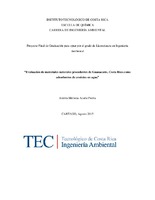Evaluación de materiales naturales procedentes de Guanacaste, Costa Rica como adsorbentes de arsénico en agua
Resumen
In Costa Rica in 2009, concentrations of arsenic were identified in water higher than the allowable limit (10 μg / L) in Guanacaste and San Carlos. Adsorption using natural materials has been successfully used for arsenic removal, especially rich in oxides / hydroxides of iron. Four natural materials from the province of Guanacaste were evaluated as adsorbents arsenic: basalt, biotite, magnetite and pumice. A multi-criteria analysis using Analytic Hierarchy Process and Grey Relational Analysis was performed for ranking materials for their potential use as adsorbents from the economic, technical and environmental point of view. Magnetite and biotite presented the best features, followed by basaltic materiales and pumice respectively. The chemical composition was analyzed by fluorescence and X-ray diffraction, showing varied compositions of iron, aluminum, titanium and silicon. The materials generate alkaline environments in contact with water, exhibit negative zeta potential at pH near 7. The BET surface areas are low: 2,68m2/g, 4,24m2/g, 5,18m2/g y 12,69m2/g for magnetite, pumice, biotite and basalt respectively. Removal evaluation was done with contact times of 10 minutes up to 48 hours, 25 ° C, 125rpm, pH 7 and 200μg/L As (V).The materials are analyzed in particle sizes between 0.1 to 1.18 mm and at concentrations of 1, 5 and 20g/L. Removal increases with time and the amount of material, however, the highest percentage of removal achieved is 74% for magnetite. Adsorption capacities were obtained by adjusting the data to the linear, Langmuir or Freundlich models, giving values below 28μg/g, considered low. Due to the low percentage of removal and adsorption capacity, the materials are not recommended as adsorbents for arsenic, despite being inexpensive, easily accessible and iron compounds.
Key words: Arsenic, Water treatment, Adsorption, Natural adsorbents.
Descripción
Proyecto de Graduación (Licenciatura en Ingeniería Ambiental). Instituto Tecnológico de Costa Rica. Escuela de Química. Carrera de Ingeniería Ambiental. 2015.


